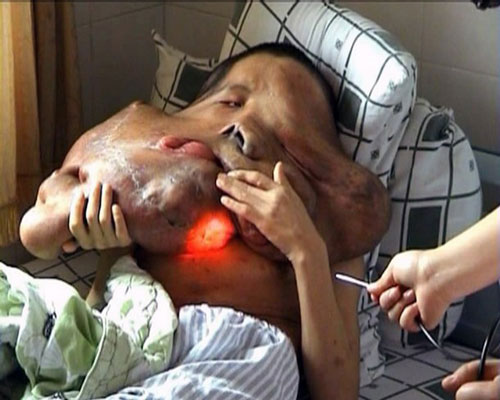Secret decoding of 'elephants'
Scientists have solved the riddle of the cause of the terrible body deformation of people with Proteus syndrome, also known as 'elephant'.
After a century since the world's first 'elephant' Joseph Merrick died, American experts have identified a genetic mutation causing Proteus syndrome - a rare disorder in the ministry. The gene makes the tissue and bone overgrowth make the body horribly deformed. There are about 500 people in the world suffering from this condition, which occurs spontaneously in the fetal stage. People with the syndrome must wear a distorted appearance, characterized by large distorted head and limbs, protruding, deformed body.

An elephant patient in China - Photo: Connect
Therefore, the above study by scientists of the National Institute of Medicine (NIH) in Washington has a tremendous meaning, which can help open up the treatment of this condition. At the same time, the results may also aid in the treatment of cancer, the disease that occurs due to the overgrowth of cells in different parts of the body. The next step is to test DNA on the skeleton of Joseph Merrick , the famous 19th-century "elephant" in the West. Unlike today's elephants, Merrick earned a living by showing off his terrible form in the UK and Europe. The story of his life attracted the attention of the whole world through musicals and the film was adapted with the same name in 1980. Accordingly, Merrick's unusual condition emerged from childhood. , in the form of thick skin patches full of tumors, unusually wide mouths and rough bones on the forehead. One arm and both legs swelled up, and until he matured he had to sleep sitting because the head was too big and too heavy.
'Elephant' Merrick became friends with Frederick Treves, a surgeon at London Hospital, where he lived his last years and died there in 1890 at the age of 27. The cause of death was determined to be suffocating, but Dr. Frederick said he died of dislocated neck. Merrick's skeleton was stored in the hospital's pathology department, and tissue was used by American experts in their attempt to study this bizarre disease. However, this is a very difficult task, because the gene mutation causes Proteus to not distribute evenly in the body. If small samples are taken, scientists may not be able to find the gene that carries the gene.
Eric Green, director of the NIH National Institute for Genetic Studies, said rare mutations like elephants have always attracted the attention of countless people, but so far cannot explain clearly in terms of medical. According to research published in The New England Journal of Medicine, patients and their relatives may hope for future therapies.
- Attempt to decipher the elephant secret
- Elephants also have their own language as humans
- Why is it difficult to see elephants confirm?
- Rare dwarf elephants die in mass
- Secret decoding of the
- Why is the 'giant' elephant afraid of 'tiny' ants?
- Giant elephants release technology like smoke ... smoking in the forest in India
- Elephants turn into 'murderers' when migrated
- Video: Rescue the eleven elephants stuck in mud holes in Cambodia
- African elephants are evolving into ivory because of excessive poaching
- Vietnam forest elephants are in danger of extinction
- Elephants speak because they are so close to people
 Green tea cleans teeth better than mouthwash?
Green tea cleans teeth better than mouthwash? Death kiss: This is why you should not let anyone kiss your baby's lips
Death kiss: This is why you should not let anyone kiss your baby's lips What is salmonellosis?
What is salmonellosis? Caution should be exercised when using aloe vera through eating and drinking
Caution should be exercised when using aloe vera through eating and drinking Attempt to decipher the elephant secret
Attempt to decipher the elephant secret  Discover the mystery of 'the elephant'
Discover the mystery of 'the elephant'  Find out the mystery of the Elephant's death
Find out the mystery of the Elephant's death 